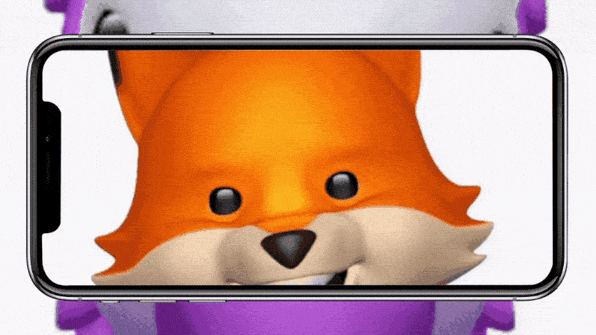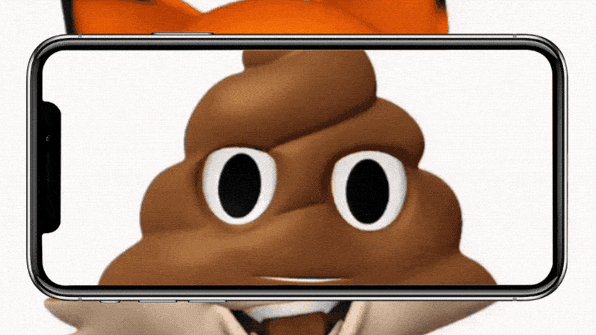In the end, it’s not about the camera. It’s not about the screen. It’s about seeing yourself as . . . a singing fox?
It doesn’t matter if the iPhone X is a user experience nightmare or if it represents the triumph of meaningless marketing. Wall Street is predicting that it will be a success anyway.
But why, if it has so many glaring design and usability defects? Some may point to Apple’s devoted fans. If Apple started calling Phil Schiller’s socks “Bionic Skins” and released a video of Jony Ive waxing lyrical about their aeronautics-grade wool, Apple fans would buy them. (In fact, Apple already did something like this.) But there are only so many fanboys in the world capable of sinking $1,000 on this fragile glass sham. Others may argue that the key to the iPhone X’s predicted success is the natural iPhone upgrade cycle. A Morgan Stanley report published by BGR predicts that in 2018, “Apple will ship 262 million iPhones on strong replacement demand.” Of those, the analysts estimate 47% will be the iPhone X. Indeed, 122 million OLED glass sandwiches is a lot. But still, even if we believe these projections, the majority of the upgrades will go to other iPhones–like the more sensible option, the iPhone 8.
Why are so many people still projected to pick the much more expensive phone? Apple’s diehard fans and the ebb and flow of the upgrade cycle may be factors, but I’m going to put all my chips on the feature that I think will make the iPhone X not only a success among the fanboys and the upgraders, but perhaps even among many Android users: those stupid animoji. Yes, the thing everyone laughed about at the keynote:
Apple has an exclusive proposition in this silly feature–a feature that all kids and many adults secretly love, as The Verge declared this week. A Google Search returns 2.9 million entries on animoji, with 133,000 in the last week alone, and hundreds of thousands of news articles. “We’re addicted to it,” says the site Popsugar. Silicon Beat calls it “viral gold.” On Reddit, hundreds agree that “you shouldn’t buy an iPhone X because animoji will ruin your life.” There’s a whole Animoji Karaoke subreddit. People are recreating famous movie scenes with the technology.

On the other side of the smartphone divide, dozens of fake animoji apps have appeared overnight, trying to scam envious Android users who are frantically searching for an animoji app after being exposed to the ongoing animoji viral wildfire. They’re out of luck. While Samsung and other Android manufacturers race to clone a similar 3D camera technology, all of those Android users will have to wait or switch to iPhone X. As animoji spread from screen to screen, they may go from being a novelty to an object of desire–the Next Big Thing.
It wouldn’t be the first time that a piece of software has made all the difference; killer apps have helped launch new hardware before. Several killer apps saved the Apple Macintosh from destruction and catapulted it into success back in the late 1980–namely Word, QuarkXpress, and Photoshop. The IBM PC became the number-one personal computer in the world arguably because of WordPerfect and Lotus 1-2-3. The iPhone itself debuted with three killer apps (Mail, Safari, and iPod) that made it the must-have smartphone regardless of its much-reviled lack of keyboard. While it’s hard to compare animoji to these genuinely useful pieces of software, consumer-facing apps are increasingly important drivers. You could argue Instagram was a killer app for two years, the time between its first iOS and Android releases. Android users coveted it badly. The same thing happened with Snapchat after it debuted on iOS in July 2011–envious fandroids bit their nails for more than a year before it hit their phones.

All that software drove spectacular hardware sales–it was the definitive key to the widespread success of those machines. I think the same thing could happen with animoji. Snapchat has the only thing that comes close to this functionality, using the same hardware technology to create iPhone X-only filters that map textures or morph your face. However, animoji don’t just augment you. They turn you into an icon, changing your persona and adding an additional layer of meaning to the nonverbal communication trend–what some would call a spiral of idiocy and others would deem a definitive cultural force. Who doesn’t want to morph into a Pixar-esque character to remind their friend to bring beer to the party–and annoy the hell out of her?
It’s too early to definitively say where this is all going to end. Maybe animoji will be just another fad. But looking at the historical precedent and the initial reception by users and the press, I think these dumb animoji could be the iPhone X’s killer app–the pinnacle of technology today. May God have mercy on us all.
–
This article first appeared in www.fastcodesign.com
Seeking to build and grow your brand using the force of consumer insight, strategic foresight, creative disruption and technology prowess? Talk to us at +9714 3867728 or mail: info@groupisd.com or visit www.groupisd.com

